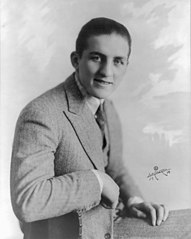| Georges Carpentier | |
|---|---|
 | |
| Born |
January 12, 1894 Lievin, Lens, Pas-de-Calais, France |
| Died |
October 28, 1975 (aged 81) Paris, France |
Georges Carpentier (pronounced car-pont-yay) (January 12, 1894 – October 28, 1975) was a French boxer and actor. He fought mainly as a light heavyweight and heavyweight in a career lasting from 1908-26. Nicknamed the "Orchid Man", he stood 5 feet 11 1⁄2 inches (1.82 m) and his fighting weight ranged from 125 to 175 pounds (57 to 79 kg). Carpentier was known for his speed, his excellent boxing skills and his extremely hard punch. Halle Georges Carpentier is named after him.
Biography[]
Born in Liévin near Lens, Pas-de-Calais, Carpentier began his career by progressing up through the weight divisions, fighting in every division from welterweight upwards. With his first professional bout at age 14, he was welterweight champion of France and of Europe in 1911, middleweight champion of Europe in 1912, and light heavyweight champion of Europe in 1913. On June 1, 1913, he beat "Bombardier" Billy Wells in Ghent, Belgium to become heavyweight champion of Europe. He defended his title in December against Wells, in January 1914 against Pat O'Keefe and in London on July 16 he beat Ed "Gunboat" Smith to add the "White Heavyweight Champion of the World" to his European title. The white heavyweight title bout sported a purse worth 9,000 pounds sterling (equivalent to approximately $995,947 in today's funds[1]).
Carpentier was also a referee during the early stages of his career, supervising a number of fights including the world title bout between Jack Johnson and Frank Moran in June 1914. Carpentier was an aviator during World War I and was awarded two of the highest French military honors, the Croix de Guerre and the Médaille Militaire. This served to heighten his already exceptional popularity, not only in France but in the United States and England as well.

Jack Dempsey and Georges Carpentier boxed in the first million-dollar gate.
Carpentier defended his title twice again in 1919 before dropping down a weight to challenge Battling Levinsky for the light heavyweight championship of the world. The fight took place on October 12, 1920, in Jersey City and Levinsky was knocked out in the fourth. Carpentier's attempt at the heavyweight Championship of the world came on July 2, 1921, again in Jersey City, when he faced Jack Dempsey in front of boxing's first million dollar gate (equivalent to approximately $13,222,015 in today's funds[1]). Carpentier was badly beaten around before suffering a knockout in the second minute of the fourth round. Carpentier never fought again for that title. He lost his world light heavyweight title and his European heavyweight and light heavyweight titles the following year, on September 24, 1922, in a controversial bout with Senegalese fighter Battling Siki. His last truly noteworthy fight was on July 24, 1924, with Gene Tunney at the Polo Grounds in New York; Carpentier lost the bout by TKO after fifteen rounds. He retired from the ring after a final exhibition bout in 1927.
Following his retirement from boxing, Carpentier spent a number of years a vaudeville song-and-dance man, mostly in England and the US. He is the author of a boxing novel, "Brothers of the Brown Owl a story of the boxing ring" published c1920 by Cassell and Company (being a volume in the uniform Cassell's Empire Library). He also appeared in half a dozen motion pictures, starring in both silent films and talkies. He made three films in Hollywood, one for director J. Stuart Blackton in England and two in his native France. His last screen appearance was in 1934. Soon after, he became proprietor of an upmarket bar, Chez Georges Carpentier, in a chic Paris neighborhood. In several different locations, this is the profession he would exercise until shortly before his death.
Beginning in 1921 and continuing throughout the rest of their lives, he and one-time opponent Jack Dempsey would remain close friends, visiting back and forth in New York and Paris, getting together to commemorate anniversary of their famous bout and exchanging birthday greetings.
Death[]
Carpentier died in Paris in 1975 of a heart attack, and was buried in the cimetière de Vaires-sur-Marne, Seine-et-Marne, France.[2]
Legacy[]
He was elected to the International Boxing Hall of Fame in 1991.
Selected filmography[]
- A Gipsy Cavalier (1922)
- The Show of Shows (1929)
- Hold Everything (1930)
References[]
- ↑ 1.0 1.1 Consumer Price Index (estimate) 1800–2014. Federal Reserve Bank of Minneapolis. Retrieved February 27, 2014.
- ↑ Radosta, John S. (October 29, 1975, Wednesday). "Georges Carpentier, Boxer, Dies in Paris; He Fought Dempsey at Boyle's Thirty Acres in 1921". New York Times. http://select.nytimes.com/gst/abstract.html?res=F7091FFF3E55157493CBAB178BD95F418785F9. Retrieved 2008-10-16. "Georges Carpentier, who lost on a fourth-round knockout to Jack Dempsey in boxing's first $1million gate, died last night of a heart attack. He was 81 years old."
External links[]
- Professional boxing record for G from BoxRec
- Carpentier vs Gene Tunney - Fight by Rounds - July 25, 1924
- Carpentier vs Gene Tunney - July 25, 1924
- Georges Carpentier at the Internet Movie Database
- Georges Carpentier at Virtual History
| Wikimedia Commons has media related to Georges Carpentier. |
The original article can be found at Georges Carpentier and the edit history here.